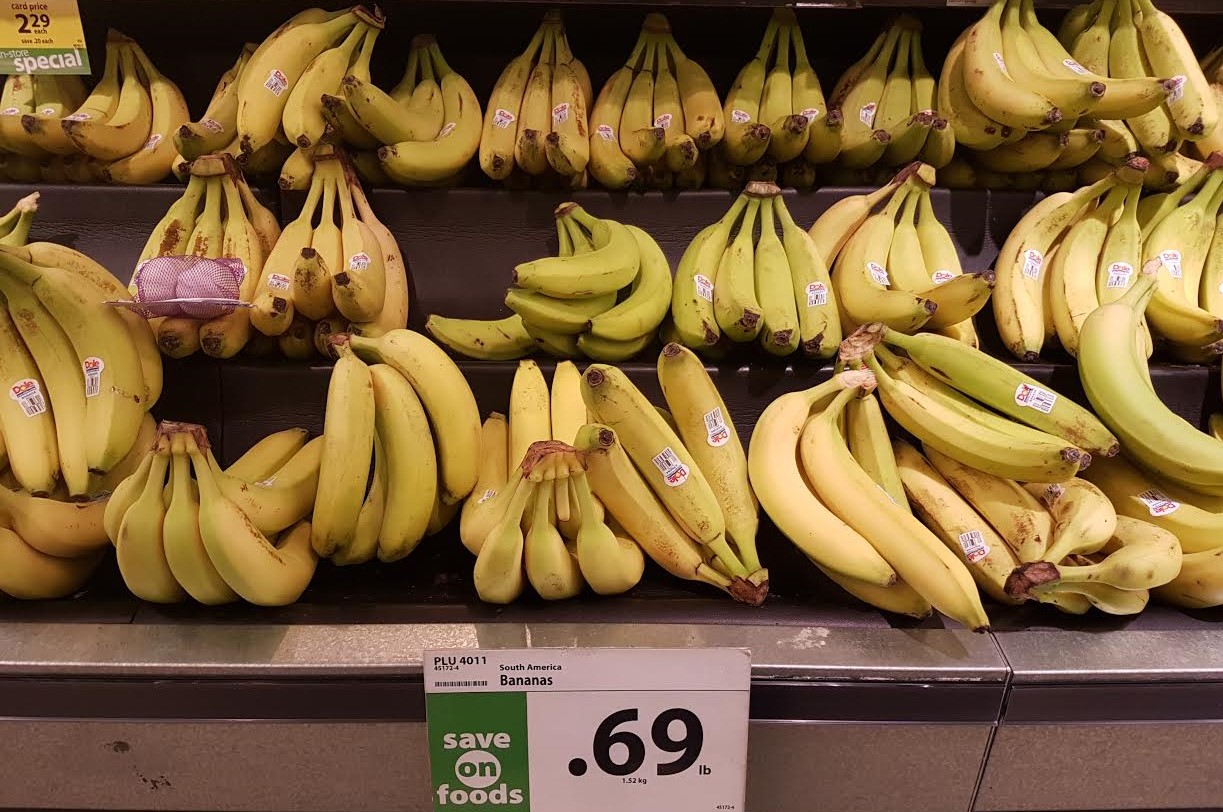Delicious Exploitation: Realities of Banana Production
The above picture was taken in the produce section of Save On Foods market in Wesbrook Village. The tag shows the price of $ 0.69 for a pound of bananas, and indicates “South America” where the specific country of origin is supposed to be. The choice of such a generalized geographic region could be attributed to the seller of these bananas (Dole) obtaining them in many countries across South America, however, it also homogenizes the continent and blurs possibilities of tracing production processes down the commodity chain. The shopper is left with a barely traceable commodity, existing only as what it is marketed as – healthy, cheap, exotic food popular among Canadians of all ages.
Such meanings attached to bananas are on the surface benign enough to not be overtly connectable to the history of exploitation of Indigenous lands that precedes them. Banana production and its expansion through industrial capitalism was traditionally presented by English speaking writers as part of civilizing “pestilential” regions of the tropics (Soluri, 2002). Dispossession of Indigenous peoples was downplayed and the land they once heavily populated presented as “useless jungle”, only made into something worthwhile by white involvement and “modernization” of the region through recognition of “tropical fertility” (Soluri, 2002). These romanticized ideas of exploitation persist today, in large part due to large corporations’ ability to hide the levels of exploitation of workers in their plantations.
Anouk (2012) emphasizes the importance of the world systems approach in analysis of commodity chains. In its most simple terms, this approach notes economic dominance, and subsequent exploitation of certain countries over others, through control over means of production and with the end result of unequal distribution of resources (Corrigal-Brown, 2016). Within this approach, lesser enforcement of labour and environmental laws in main exporters of bananas (ie. Ecuador or Guatemala) are what makes multinational corporations such as Dole choose them as the production sections of their commodity chains. Unregulated low wages often necessitate employment of entire families, resulting in frequent child labor within banana production (Forero, 2002). Aside from receiving wages that barely cover costs of living, these children and other workers are kept in unsafe conditions of frequent and aversive exposure to agrochemicals (Human Rights Watch, 2002).
In addition, work in plantations is often heavily gendered. As noted by Anouk (2012), there is a general trend in commodity production where men obtain more specialized jobs while women are often temporary workers, deprived of access to benefits and with lesser opportunities to move up in positions. This holds true for banana production, as the percentage of women employees in plantations in South America drops to as low as 7% due to construction of the female employee as risky and costly since there is a possibility of pregnancy. This is exemplified in requirement of women workers to provide medical proof of not being pregnant in certain countries (Bananalink, n.d.). Meanwhile, the women who are employed in plantations are typically left on uncertain short-term contracts, and paid less than men as they are assumed to be physically weak and are therefore restricted to less demanding but lower paying roles (Bananalink, n.d.). Ironically, it was the increased entry of working-class women into the workforce in North American countries that popularized bananas to the extent that expanded production of them became necessary (Soluri, 2002). Local demand for cheap ready-to-eat foods such as bananas at the consumerist end of the commodity chain influenced productions conditions in countries of export. While popularized consumption of bananas can be interpreted as an effect of increased women’s rights in certain places, it leads to breaches of women’s rights in other areas of the globe.
It is true that bananas are healthy and (typically considered) delicious, however, these properties should not be used to mask the realities of working conditions, and exploitative systems that bring them to local supermarkets. Within a system of global social and economic inequality, commodities that are taken for granted often hide histories and contemporary realities of oppression. In the case of bananas, it is important to question and unveil production processes in countries of origin in order to find sources that treat workers with dignity.
References
Bananalink. (n.d.). Retrieved from http://www.bananalink.org.uk/sites/default/files/Women%20and%20the%20banana%20trade%202016_1.pdf
Corrigall-Brown, C. (2016) Imagining Sociology: An Introduction with Readings. Oxford University Press.
Forero, J. (2002, July 13). In Ecuador’s Banana Fields, Child Labor is Key to Profits. The New York Times.
Human Rights Watch. (2002). Tainted Harvest: Child Labor and Obstacles to Organizing on Ecuador’s Banana Plantations. Retrieved from http://www.hrw.org/reports/2002/ecuador/2002ecuador.pdf
Patel-Campillo, Anouk. (2012). The gendered production-consumption relation: accounting for employment and socioeconomic hierarchies in the Colombian cut flower global commodity chain. Sociologia Ruralis, 52(3): 272-293.
Soluri, J. (2002). Accounting for Taste: Export Bananas, Mass Markets, and Panama Disease. Environmental History, Vol. 7 No 3, pp. 386-410.
